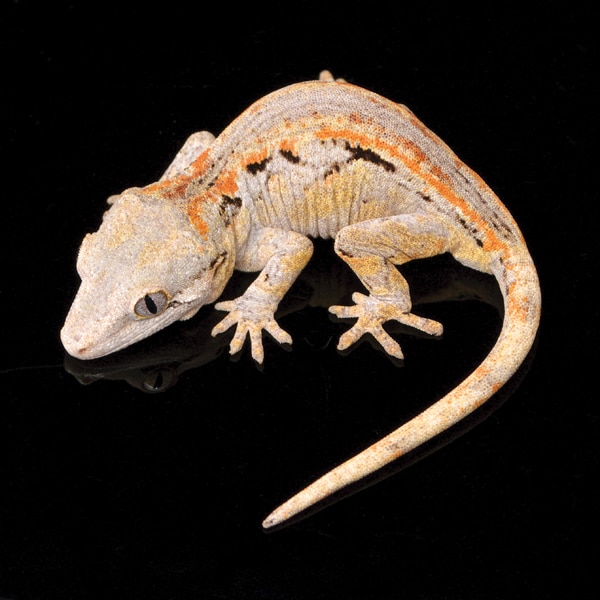The gargoyle gecko has simple care requirements and awesome-looking morphs are available
Like the ever-popular crested gecko (Rhacodactylus ciliatus), the gargoyle gecko (R. auriculatus) is another heavy-bodied gecko endemic to New Caledonia, located in the southwest Pacific Ocean in relatively close proximity to Australia and New Guinea. Its natural range is rather small, being restricted to the lower third of Grand Terre, the main island of New Caledonia. The climate on New Caledonia is considered tropical, but there are distinct dry and wet seasons, with short intermediary periods between. Because of its small size and geography, the weather is fairly variable, and largely dependent on ocean winds, but the one constant is high relative humidity.
The gargoyle gecko’s Latin species name, auriculatus, refers to the superficial appearance of ears on the lizard’s head. These are actually projections that develop on the parietal bone of the skull, and the gecko’s common name, also referring to these unique projections, is more self explanatory.
As evidenced by the gargoyle gecko’s underdeveloped toe pads, it is a semi-arboreal species at best, that tends to favor thick, low scrub and vegetation—terrain that presumably keeps it concealed from any birds circling above, as well as off the ground, away from terrestrial predators.
Gargoyle Gecko Behavior in Captivity
The gargoyle gecko, which can live up to about 20 years in captivity, is a relatively laid-back species when it comes to human interaction and can be easily handled for short periods of time. When doing so, let the gecko climb, or leap, freely from one hand to the other if it is so inclined. Eventually it will settle down. Do not try to restrain a gargoyle gecko from moving, or it may attempt to bite, squirm, or even drop its tail. Another problem with restraining a gecko, especially a hatchling, is that doing so can cause its body to overheat, which can result in death.
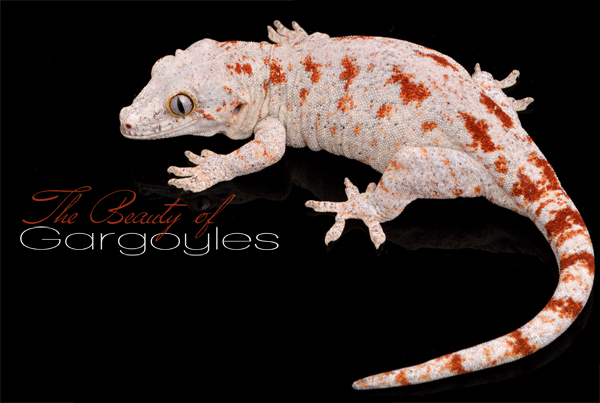
Anthony Caponetto
The gargoyle gecko is a relatively laid-back species when it comes to interaction with humans. This is an adult with red blotches on a pale white background color. It’s a banded-type gargoyle, but this lineage was bred for a very muted pattern.
Bites from gargoyle geckos don’t typically hurt. When a gargoyle gecko bites, it’s usually just a quick nip—they do not hold on. You may feel a pinch due to their teeth, but in my experience any pain is very minor, subsides almost instantly, and their bites rarely break the skin.
Gargoyle geckos often behave aggressively toward each other when housed together. In fact, it is rare that an entire 1.3 (one male and three females) breeding group will all have their tails, and it’s even more rare for a breeder male gargoyle to have a tail longer than a couple of inches. Gargoyle geckos almost always eat the wriggling, autotomized tails of their cagemates.
I raise gargoyle geckos individually until they reach breeding age, so they can grow to adult size without having to compete with a larger gecko for food. If kept together, especially hungry, growing juveniles, you will likely notice that one gecko gets the lion’s share of food. This more dominant gecko may then grow twice as fast as the others, potentially to a size where it could injure or kill its smaller cagemates.
Gargoyle geckos are able to make short, high-pitched vocalizations. I’ve never noticed any sort of mating calls, but they will squeak and grumble at one another during breeding activity. They may also vocalize at their owners during the rare instances they may need to be restrained, usually in order to remove a retained shed, or to remove dried food from their toes.
Like many lizards, gargoyle geckos will autotomize (drop) their tails when they feel threatened. A tail about to drop usually starts to wiggle first, before popping off at the base. It will then thrash wildly on the ground, creating a diversion to allow the now-tailless gecko to escape predation. It’s like a Get Out of Jail Free card that continues to regenerate throughout the gecko’s lifetime.
A common myth is that if you pull a gecko’s tail, it will automatically drop it. After hatching tens of thousands of geckos over the past 11 years, I have learned this is not the case. I have exceptionally laid-back gargoyle geckos that allow me to lift them by their tails without so much as grumbling at me. Then there are the exceptionally nervous ones that spook without even being touched and will drop their tails. I believe tail autotomization is a nervous response to fear, rather than a conscious decision drop the tail.
A gargoyle’s tail will regenerate over a period of a few months. It’s one of the only species I’ve worked with in which a regenerated tail can be difficult to discern from the original. With most others, a regenerated tail is oddly shaped and/or colored, but the only way to tell that a gargoyle’s tail is regenerated is by looking closely at the scalation. The rows of scales on an original tail have a symmetrical appearance, whereas those on a regenerated tail usually appear slightly asymmetrical.
Gargoyle Gecko Colors and Patterns
Gargoyle coloration generally includes earth tones such as creams, yellows, tans and browns, usually with some black patterning. Selectively bred specimens can lack yellow pigment altogether, creating a pure black and white adult coloration, and rare specimens exhibit a deep crimson base color (the latter are highly prized by breeders and collectors).
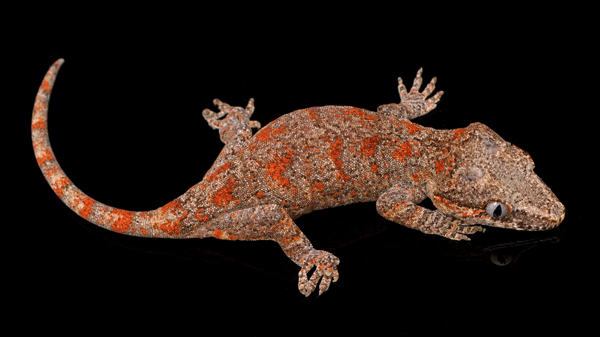
Anthony Caponetto
Juvenile with red blotches and deep red and black mottled background color.
Like its cousin the crested gecko, the gargoyle gecko is polymorphic. This means multiple pattern and color combinations are found in the wild, unlike species that generally exhibit a single, wild-type appearance, such as bearded dragons, leopard geckos and ball pythons.
Though gargoyle geckos may exhibit a more uniform granite or marble-like appearance, with no distinct patterning, there are three pattern types that can be found in the trade.
Striped. Striped gargoyles, with stripes running the length of the body from the base of the skull to the tip of the tail, have become increasingly common in the pet trade over the past decade. In my experience, this trait has proven to be dominant, meaning that only one striped parent is necessary to produce striped offspring. When a striped gargoyle is bred to a different pattern type, roughly half of the resulting offspring will exhibit a striped appearance. When bred together, not all offspring will be striped, while on the other hand, some will exhibit an even more symmetrical striped appearance, indicating a homozygous, or ìsuper,î form of the striped appearance.
Banded/Reticulated. Some gargoyles I work with exhibit dark reticulations zigzagging across the dorsal surface, usually on a pale gray or white background. Banded specimens display alternating bands of lighter and darker shades of cream or tan between the reticulations.
Red and Orange Blotch. This trait looks like it sounds and works independently of the basic pattern and base color. Gargoyles displaying this trait are arguably the most sought after of all. Selectively bred specimens can be quite striking, not to mention expensive. In addition to one of the previously mentioned pattern types, bold orange or red blotches will appear in either a linear or randomly scattered pattern along the dorsal surface, depending on the basic pattern of the gecko. —Anthony Caponetto
Gargoyle Gecko Housing and Environment
While just about any type of secure cage will suffice, provided humidity and temperature parameters are met, I do not subscribe to the theory that a cage for a semi-arboreal gecko such as the gargoyle gecko should be taller than it is wide. Remember, the occupant(s) have to travel to different areas on the floor of the cage to eat, drink, breed, lay eggs, and rest. Wild gargoyles are usually found in dense brush within a few feet off the ground, and along the edges of trails and clearings. I find that captive gargoyles prefer to hide under something on the floor of the cage, and when they’re out and active, they’re almost always within 6 inches of it. Using a cage taller than it is wide only serves to make it more difficult to maintain humidity, and potentially costs you valuable floor space.
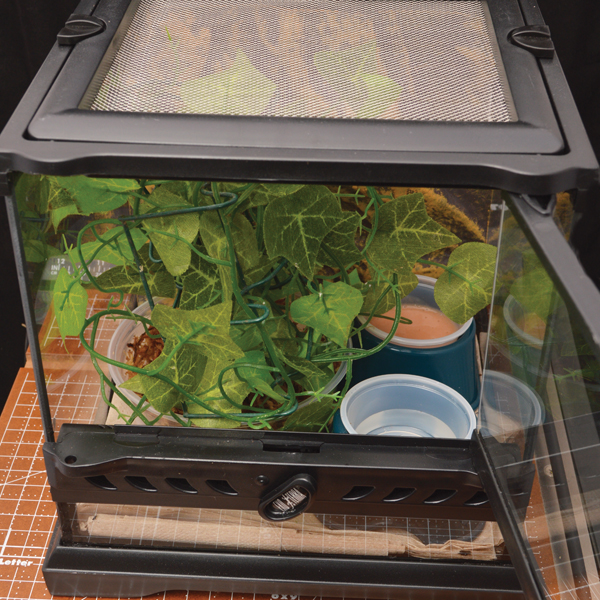
Anthony Caponetto
For a single adult gargoyle gecko, a 10-gallon or 12 by 12 by 12-inch terrarium will suffice, but slightly larger would be even better.
For a single adult gargoyle gecko, a 10-gallon or 12 by 12 by 12-inch terrarium will suffice, but slightly larger would be even better. For a breeding group consisting of several animals, I recommend an enclosure measuring 18 by 18 by 18 inches (again, larger is OK, but I recommend limiting the height to no more than 18 inches).
Commercially available storage totes made by companies such as Rubbermaid and Sterilite work well. They are lightweight, easy to clean, inexpensive and, being translucent, rather than completely clear, like glass, they also offer the geckos a better sense of security.
As a professional gecko breeder, practicality dictates I house my geckos in a more sterile, spartan cage environment, as opposed to an elaborate naturalistic setup. Naturalistic cages look great in an office or living room, but they’re more for the keeper than the kept. Needless to say, the geckos themselves aren’t too picky about decor—they’re just going to poop on it.
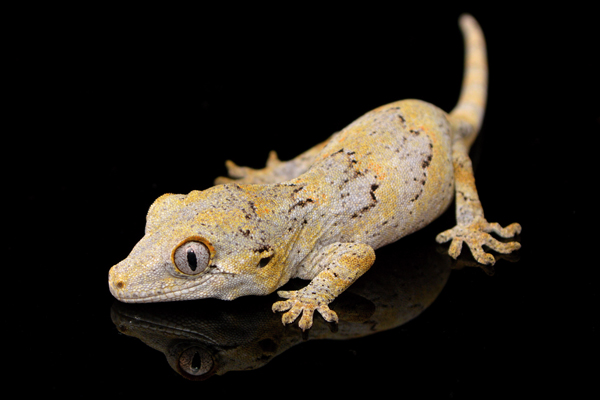
Anthony Caponetto
This is an adult black and white reticulated gargoyle gecko exhibiting orange highlights. This coloration is rarely visible on adults.
I use as many disposable/compostable/recyclable products as possible, to avoid wasting time and energy washing thousands of items each week. A typical breeding setup consists of a 58-quart tote with a lid, lined with a thick layer of newspaper. I recommend paper substrates such as newspaper, newsprint, or even paper towels, because particulate substrates such as coconut fiber or mulch present too much of an ingestion hazard for geckos that will be offered live insects. If you are feeding grubs or roaches from a bowl, both items gargoyle geckos will learn to eat, then you may be able to use a particulate substrate without issue. If crickets are a staple, though, you will inevitably end up rinsing out the mouth of a grumbling, squeaking, squirming gargoyle gecko—not a pleasant experience for either of you.
A 6-quart Sterilite tote filled with nesting substrate (see next section for more on this) is placed inside the larger tote, along with some egg carton for shelter and climbing. A section of chicken wire with artificial foliage attached is provided for additional climbing and hiding areas (this also aids in maintaining humidity), and small, tight-fitting hides are placed on the floor of the cage, as are disposable 2-ounce food and water dishes.
Humid Hide
A humid hide (or nest box if breeding geckos) is vitally important and often overlooked when it comes to keeping a cage humid and geckos well hydrated. For breeding adults, I use the previously mentioned 6-quart tote, three-quarters-full of a coconut fiber, sand and peat moss mixture that I’ve developed to be relatively harmless to the eggs. A 3-inch hole is drilled in the tote’s lid, which is then placed on the tote upside down rather than snapped into place right side up. This loose fitting allows the geckos to climb out around the edges of the tote as well as through the drilled hole.
For younger, non-breeding geckos, use a small deli cup filled with moistened sphagnum moss (paper towel will also suffice, but will need to be changed every few days) and then loosely covered to prevent it from drying out too fast; anything that cuts down airflow will work, such as part of a climbing structure, some artificial foliage, or a lid with a hole in it. This will give the gecko a cool, humid place to retreat to if it gets warm or when it’s entering a shed cycle.
Lighting and Temperature for the Gargoyle Gecko
Artificial lighting, including UVB, is unnecessary and not recommended due to the potential for overheating the cage. These geckos tend to hide in shade during the day, so adding a light directly overhead will likely cause them to hide. Ambient light provides an ideal photoperiod and mimics the filtered sunlight gargoyle geckos would experience in the dense brush they tend to inhabit in the wild. Never place the cage in direct sunlight, as this can cause it to quickly overheat.
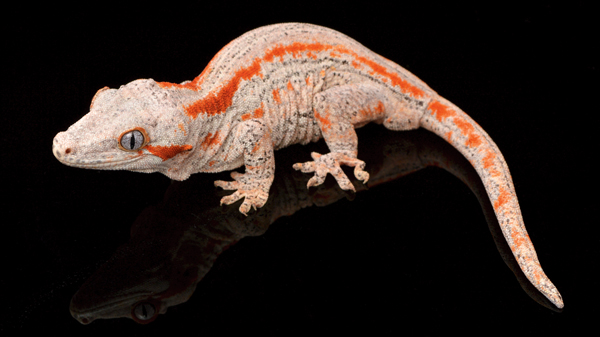
Anthony Caponetto
This adult is exhibiting red blotches that have taken the form of bold red stripes. Note the amount of red in the face of this exceptional specimen.
Gargoyle geckos do very well at room temperature, and typically can be maintained without any supplemental heating or lighting. Temperatures in the 75 to 84-degree range are what I like to shoot for in a captive environment, with 80 degrees being ideal for juveniles and adults. Hatchlings weighing less than 10 grams tend to stay better hydrated at the cooler end of that range. Gargoyle geckos can safely withstand temperatures down into the 40s overnight, provided they are allowed to warm back up during the day. That said, I don’t recommend letting them get this cool on a regular basis.
Adults tend to benefit from a spike in temperature at the height of the day, but will not fare well if you keep them at a constant 84 degrees. If you add heat, which is completely optional, be absolutely sure there’s a cool end of the cage for the gecko to retreat to. Gargoyles are far more heat tolerant than crested geckos, and can tolerate cold temperatures equally well.
Humidity and Shedding
After many years of trial and error, I’ve found 60 to 65 percent to be the ideal relative humidity for gargoyle geckos. A higher percentage will promote bacterial/fungal growth and lower will result in stuck sheds and geckos that look unhealthy.
If you have only one or a handful of cages, humidity can generally be maintained by a light misting of a cage’s interior every day or two, depending on the humidity in the room itself. Don’t soak the cage; just lightly cover the interior with water droplets, just enough so that they will evaporate within 24 hours. If droplets remain for 24 hours, you either misted too heavily or your cage doesn’t have enough ventilation.
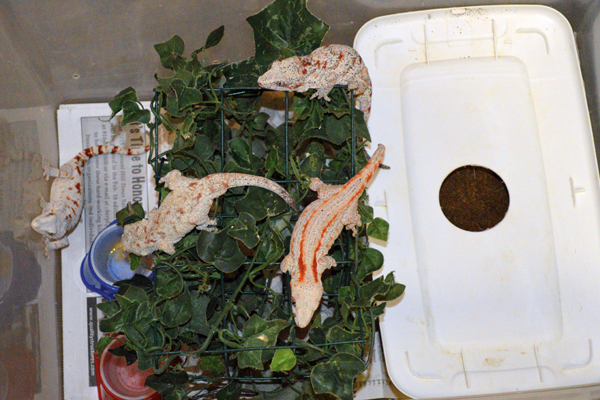
Anthony Caponetto
This is the author's standard breeding setup for 1.3 adult gargoyle geckos. It features a 58-quart Sterilite tote, egg carton and artificial foliage, non-tip food and water bowls and a 6-quart nest box with a lid with a hole cut into it.
For a room containing a large number of cages a humidifier for the entire room is recommended to maintain proper humidity levels.
Sheds are more frequent in young geckos that are growing at a rapid rate, and temperature and food intake dictate how often they shed. Gargoyle geckos, like many other species, tend to eat their shed skins, sometimes leaving their owners to mistakenly wonder why their geckos are not shedding.
A retained shed, or dysecdysis, is a common problem with just about any reptile species, and is almost always caused by improper humidity levels (and, to a lesser extent, suboptimal internal hydration). I highly recommend that you use a hygrometer to monitor relative humidity. This simple gauge will cost you about $5, and will allow you to monitor humidity so that you can make any necessary changes before your gecko starts showing signs of dehydration.
Generally, there are two reasons for a retained shed on a gargoyle gecko: it’s either too dry or too damp in the cage. When a gecko goes into a shed cycle, it will look opaque for a short period, due to a light layer of fluid that builds up between the new and old layers of skin. This acts as a lubricant to aid in the old skin being shed. If the cage is too dry, this fluid dries out before the gecko can get the old skin off, and it tends to act more like an adhesive than a lubricant.
If the shed appears to be dried on, soak the gecko for a few hours by placing it in a deli cup with a piece of wet paper towel. Never leave a gecko in standing water—it’s too easy to accidentally add too much water and end up having a gecko drown. Sometimes the gecko will shed on its own while in the cup, other times you may have to peel the retained shed off manually.
If the retained shed is clinging because it’s too wet, clean and dry the cage, and let the gecko dry out for a few hours before attempting to remove the shed. Remember, handling a small gecko for extended periods can cause it to overheat, so be careful not to hold it too tightly when removing the retained shed.
Diet, Nutrition and Water for Gargoyle Geckos
I feed my gargoyle geckos every two to three days, except during the winter, when they’re fed twice per week. I use and recommend the fruit mixes made by Pangea Reptile for geckos. They are slightly more expensive than competing products, but the powder is finer, allowing it to mix more completely. This results in a final product with a much smoother texture that my geckos seem to favor over any other. Pangea diets also resist mold, even in humid environments, and contain everything your gargoyle gecko needs, nutritionally speaking. The three macronutrients—proteins, carbohydrates and dietary fats—are in proper proportions, and the micronutrients (vitamins and minerals) are also included at proper levels. Even natural plant pigments are included. You don’t need to add anything but water.
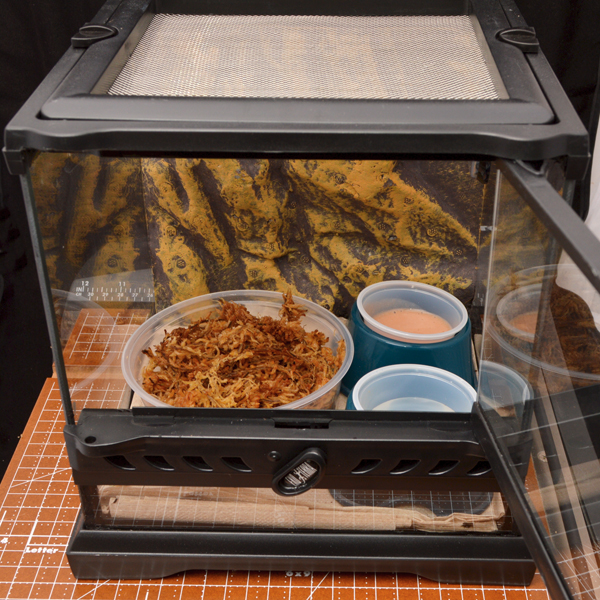
Anthony Caponetto
A simple enclosure with a food and water bowl and moistened sphagnum moss.
If you have only one or a couple of geckos, prepare batches of this diet by using either a shaker cup or a blender, and pour single servings into individual 1 or 2-ounce disposable plastic soufflé cups with lids. Place these in the freezer and use as needed by simply leaving a cup of the frozen diet out overnight to thaw before offering it the next day. You can also use an ice cube tray with similar results, but I like the convenience of having the food already in the souffle cup, ready to eat.
In addition to the commercial Pangea diet, I strongly recommend offering gargoyle geckos insects on a regular basis. I offer crickets and other insects to juvenile and older gargoyle geckos at least once per week. Insects are dusted with Rep-Cal calcium with vitamin D3 every time they’re offered. Insects are also gut-loaded by feeding on vitamin-rich, leafy greens such as kale and spinach prior to being fed to the geckos. Calcium supplementation is especially vital for geckos that are still growing, as well as females that are actively breeding.
The rule of thumb for most geckos is to offer insects no longer than the width of a gecko’s head, but that rule usually has to be broken to get gargoyles interested in eating insects. I begin offering crickets once a gecko is 2 months old. Before that, they prefer fruit-based diets, such as the Pangea foods. Adults tend to enjoy mixed diets as much as they do insects.
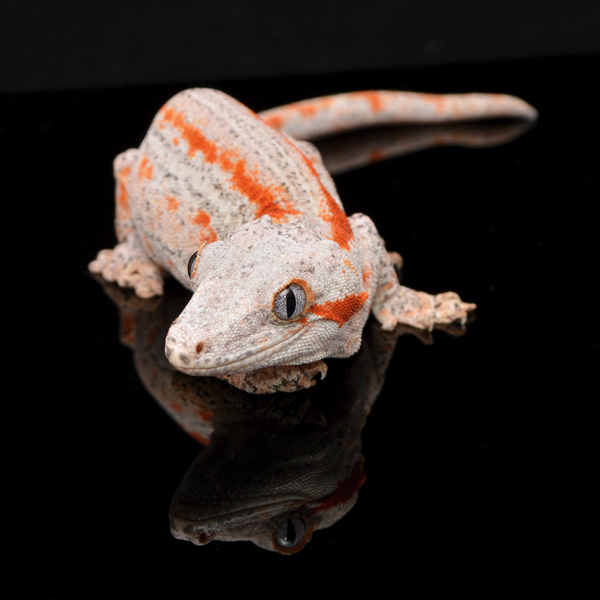
ANTHONY CAPONETTO
Gargoyle geckos make great pets.
Gargoyle geckos will readily drink from a shallow water bowl and one should always be placed on the floor of the cage. Babies are often afraid to venture out to the water bowl. This can lead to dehydration, resulting in suboptimal growth rates over time. Provide them a secure route to the water, such as a section of egg carton or other cover placed nearby.
In a larger cage, such as a naturalistic setup, it’s important to provide a secondary source of drinking water for hatchlings and juveniles by lightly misting every day or two. Besides stimulating the geckos to drink, this will also help to temporarily boost humidity in the cage, as mentioned previously. Be careful not to saturate the cage. Spraying the geckos themselves can also further stimulate them to drink.
Anthony Caponetto has kept reptiles since the age of 7, when he got his first house gecko. In 2004 he left a career with Gateway computer to breed reptiles full time. Today, Anthony Caponetto Reptiles (acreptiles.com) is home to the largest collection of selectively bred crested geckos in the world, consisting of more than 1,500 breeding adults, along with hundreds of breeding adult gargoyle geckos and ball python morphs.

